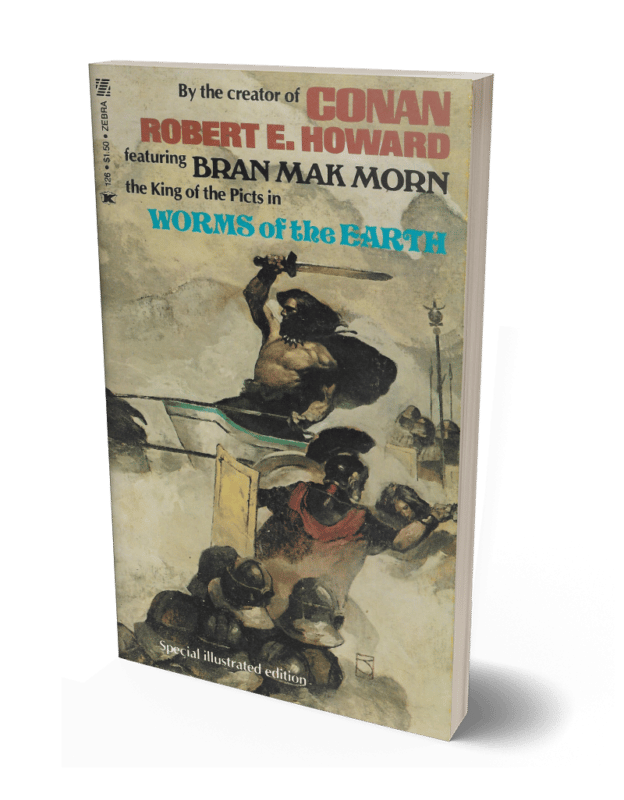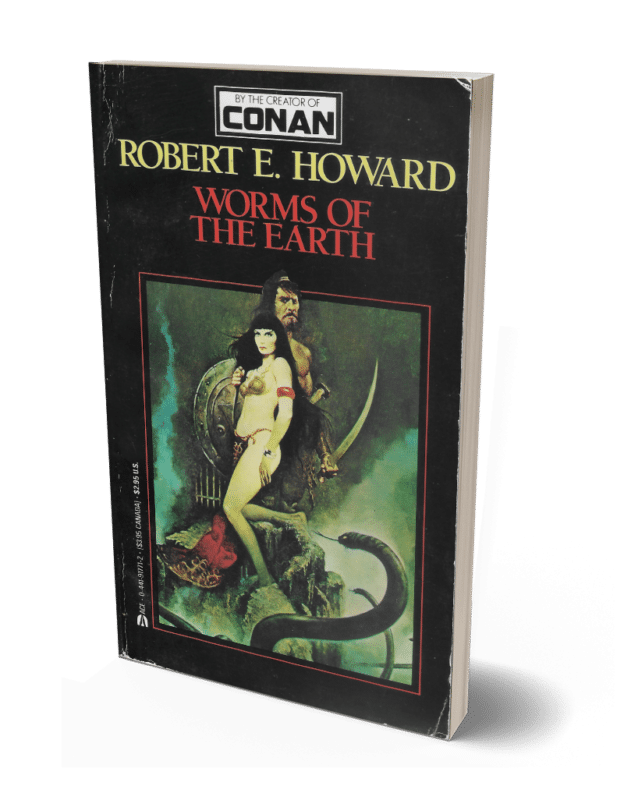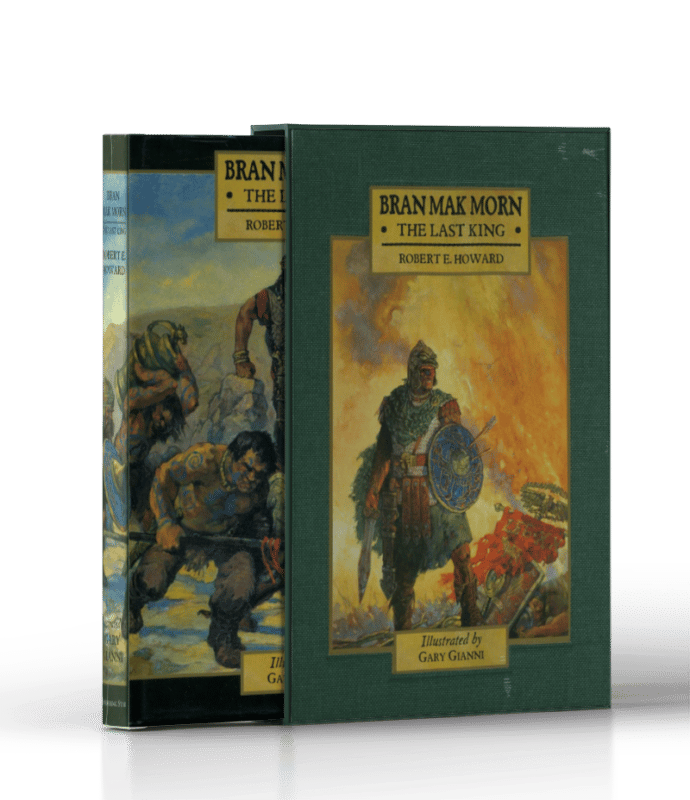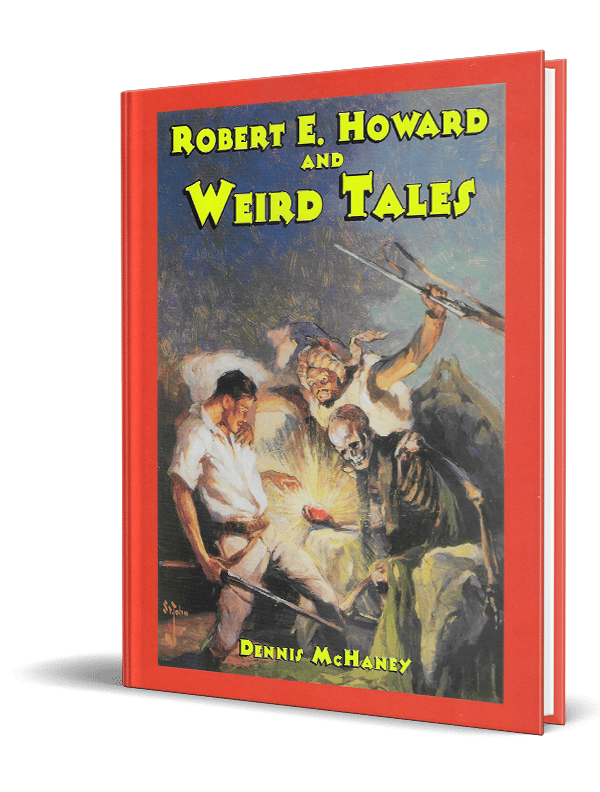Introduction
The Dark Man (first published in Weird Tales, December 1931) – Turlogh tries to rescues the daughter of King Brian Boru from a tribe of Vikings. This story features a cameo of another Howard character, Bran Mak Morn. It was also adapted as a Conan story by Marvel Comics. Howard earned $85.00 for the story.
The story was first accepted for Strange Stories, a planned companion magazine to Weird Tales. This is also the first story about Turlogh Dubh O’Brien. We learn of this in a letter (#124) to Tevis Clyde Smith, circa March 1930:
Well, Farnsworth said he was going to use “Shadows on the Road” as a full page rhyme in the issue after next. I wish he’d have it illustrated but I think they quit illustrating rhymes. Well, I’m not kicking; that’s about the quickest action I ever got on anything, for I sold it to him just recently. And he accepted a story for the new magazine. “The Dark Man” is the name of the tale and he promised me $85.00 on publication. The editor was kind enough to say it was a “red blooded, he-man story”. Well, it has plenty of gore and action. And incidently, I have created a new character to join Kull, Solomon Kane and Steve Costigan. His name is Turlogh Dubh O’Brien and I hope to have a series of stories dealing with him in the new magazine. This story, was, of course, about him. He is an Irish outlaw whose adventures are laid in the half century preceding the battle of Hastings. That’s a period teeming with intrigue, war and battles and I ought to be able to spin dozens of yarns about it.
He also wrote a letter (#145) to H.P. Lovecraft, circa November 1930:
Mr. Wright tells me that the issuing of Strange Stories is being delayed because of Macfadden’s disputing the right to the title. Several months ago he accepted a couple of my tales for the magazine, one of them dealing with the Bran cult, and I would like to see the publication on the newsstands.
And in a letter (#194) we learn why the story wasn’t published in Strange Stories, but in Weird Tales. The letter was to Kirk Mashburn, circa March 1932:
I am writing to express my appreciation for your remarks concerning “The Dark Man”, in the Eyrie of the current copy of Weird Tales. You expressed my own ideas on the matter exactly. While “The Dark Man” was not originally written for Weird Tales, but for the planned Strange Stories, which was never published, it always seemed to me that it contained enough weird touches to justify its presence in the former magazine. Thanks for coming to its defense.
There was also some negative feedback on the story. A letter from Paul S. Smith appeared in The Eyrie, in February 1932, complaining that “The Dark Man” was “not the least bit weird”:
“I have never before written you a word of adverse criticism,” writes Paul S. Smith, of Orange, New Jersey, “because I know that you are trying to put out good a magazine as you can and because as he tries to please every one, an editor’s as life sometimes, like a policeman’s, is not a happy one. But there are three stories in the December issue on which I must offer some non-commendatory statements. The Dark Man is an adventure story pure and simple, and is best suited to a magazine like ‘Adventure.’ It is well written and contains a superabundance of fighting and bloodshed for those who like these things, but it is not the least bit weird. However, many of your readers will like it—so that’s that. Dead Man’s Vengeance is an excellent Western story and its proper place would be in a Western story magazine. The touches of weirdness it contains are so slight that I honestly believe it is too mild for your magazine, Bitter Gold is a very fine little story and I am glad to have read it. This tale is grim and tragic but not weird. Here are three stories in one issue, not one of which is genuinely weird. Fie, fie, sir! Is not WEIRD TALES to be kept weird? “
In another letter (#210) which Howard wrote to Tevis Clyde Smith, very late in May 1932:
The yammerings and droolings of Paul S. Smith of Orange and his breed begin to bear fruit; Farnsworth rejected four out of the last six stories I sent him, and almost invariably the reason was given as not weird enough.
The story
“The Dark Man” is a gripping tale set in the ancient, rugged landscapes of Connacht. It begins with Turlogh Dubh, an exiled warrior of the Clan na O’Brien, encountering a fisherman on a snowy shore. Turlogh, described as a formidable and darkly handsome man, is on a mission to rescue Moira, the daughter of a Dalcassian chief, abducted by Viking raiders led by Thorfel the Fair.
After persuading the fisherman to lend him a boat, Turlogh braves a treacherous sea journey, driven by a deep sense of duty to his people despite his outcast status. His journey leads him to a scene of carnage on the Isle of Swords, where he discovers a mysterious statue amidst slain Danes and unknown dark-skinned warriors. This statue, of a man resembling the fallen warriors, exudes an aura of ancient power and is believed to embody the spirit of Bran Mak Morn, a legendary king of the Picts.
Turlogh takes the statue, feeling a strange connection to it, and continues to the Hebrides. There, in Thorfel’s stronghold, he witnesses Moira’s forced wedding to Thorfel. In a desperate act of defiance, Moira takes her own life, triggering Turlogh’s ferocious attack on the Vikings. Amidst the chaos, a band of Picts, the original guardians of the statue, storm the hall, seeking to reclaim their god.
In the ensuing battle, Turlogh and the Picts decimate Thorfel’s men. Turlogh personally slays Thorfel, presenting his severed head to Moira’s corpse as a token of vengeance. The priest Jerome, brought to perform the wedding, chooses to stay behind to tend to a wounded Viking, Athelstane, showcasing his humanity and compassion. The Picts depart with the statue, leaving Turlogh to return Moira’s body to her homeland, sailing into the west on a red-tinted sea symbolic of the bloodshed he leaves behind.
Characters
- Turlogh Dubh: A formidable and exiled warrior of the Clan na O’Brien, known for his dark hair and complexion. He embarks on a dangerous journey to rescue Moira and is characterized by his fighting prowess and deep connection to his land and people.
- Moira, Daughter of Murtagh: A Dalcassian princess abducted by Vikings. Despite her tragic fate, she displays bravery and defiance against her captor, Thorfel.
- Thorfel the Fair: A Viking raider and leader responsible for Moira’s abduction. He is eventually killed by Turlogh in the climactic battle.
- The Fisherman: A rugged individual who provides Turlogh with the boat for his journey. His interaction with Turlogh sets the stage for the rescue mission.
- Brogar: Chief of the Picts, seeking to reclaim the statue of Bran Mak Morn. He aids Turlogh in the battle against the Vikings.
- The Priest Jerome: Brought to perform Moira’s forced wedding, he showcases compassion and humanity, choosing to stay behind to tend to a wounded Viking.
- Athelstane: A wounded Viking who is tended to by Priest Jerome, symbolizing the indiscriminate nature of violence and the humanity that can emerge in its aftermath.
- Gonar: The high priest of the Dark One (the statue), who guides the Picts through his dreams and spiritual connection to the statue.
- Bran Mak Morn: An ancient king of the Picts, whose spirit is believed to inhabit the statue. His presence influences the events and aids Turlogh during his journey.
Published in:
- WEIRD TALES VOLUME 18 NUMBER 5, Popular Fiction Publishing Company, December 1931
- WEIRD TALESVOLUME 46 NUMBER 4, Short Stories Inc., September 1954
- THE DARK MAN AND OTHERS, Arkham House, 1963 (Accidentally published incomplete)
- HORROR I, Sugar Editore, March 1965 (Italian)
- NARRACIONES TERRORÍFICAS, Editorial Acervo, 1965 (Spanish)
- BRAN MAK MORN, Dell, September 1969
- THE DARK MAN AND OTHERS, Lancer, 1972 (n.d.)
- SAVAGE TALES VOLUME 1 NUMBER 4, Marvel Comics, May 1974 (graphic adaptation featuring Conan)
- WORMS OF THE EARTH, Grant, 1974
- SAVAGE TALES #4, Marvel, du
- WORMS OF THE EARTH, Zebra, July 1975 (1st printing)
- WORMS OF THE EARTH, Zebra, 1975 (Canadian edition)
- WORMS OF THE EARTH, Zebra, August 1975 (2nd printing)
- TERRA FANTASY 17: RÄCHER DER VERDAMMTEN, Erich Pabel Verlag KG, January 1976 (German)
- L’HOMME NOIR, Libraries des Champ-Elysees, 1st Quarter 1976 (French)
- WORMS OF THE EARTH, Orbit, 1976
- WORMS OF THE EARTH, Zebra, April 1976 (3rd printing)
- WORMS OF THE EARTH, Zebra, January 1977 (4th printing)
- MARVEL TREASURY EDITION #15, Marvel Comics, 1977 (graphic adaptation featuring Conan)
- SKULL-FACE, Editrice Nord, October 1978 (Italian)
- TERRA FANTASY 17: RÄCHER DER VERDAMMTEN, Erich Pabel Verlag KG, Fall 1978 2nd printing (German)
- THE DARK MAN OMNIBUS, Volume 1, Panther, 1978
- WORMS OF THE EARTH, Ace, June 1979 (1st printing)
- FATA MORGANA, J. M. Meulenhoff, 1980 (Dutch)
- L’HOMME NOIR, NeO, April 1982 (French)
- KÖNIG DER PIKTEN, Bastei Verlag, Winter 1984 (German)
- L’HOMME NOIR, NeO, February 1984 (French, 2nd printing)
- WORMS OF THE EARTH, Ace, September 1987 (2nd printing)
- BOGOWIE BAL-SAGOTH, Wydawnictwo Iskry, 1987 (Polish)
- GUSANOS DE LA TIERRA, Ediciones Martinez Roca, 1987 (Spanish)
- CONAN SAGA VOLUME 1 NUMBER 10, Marvel Comics, February 1988 (graphic adaptation featuring Conan)
- L’HOMME NOIR, NeO, February 1988 (French, 3rd printing)
- L’HOMME NOIR, Fleuve Noir, December 1991 (French)
- MAGAZÍN POUTNÍK 2: CONAN BARBAR A JINÉ POVÍDKY, Klub Julese Vernea, 1991 (Czech)
- IKARIE, Mladá fronta, September 1992 (Czech)
- ÁRNYKIRÁLYOK, Cherubion Könyvkiadó, 1992 (Hungarian)
- YÖN KUNINKAAT, WSOY, 1992 (Finnish)
- SKULL FACE, Editrice Nord, March 1993 (Italian)
- TYGŘI MOŘE, Laser Books, 1993 (Czech)
- I SIGNORI DELLA SPADA, Newton Compton Editori, March 1994 (Italian)
- ROBAKI ZIEMI, Wydawnictwo PiK, 1994 (Polish)
- TUTTI I CICLI FANTASTICI – I CICLI CELTA E DI FACCIA DI TESCHIO, Newton Compton Editori, April 1995 (Italian)
- BRAN MAK MORN, Baen, January 1996 (restored text)
- TYGŘI MOŘE, Laser Books, 1996 (Czech, 2nd printing)
- THE NIGHT OF THE WOLF, North-West, 1997 (Russian)
- LHORK 18, Círculo de Lhork, 1998 (Spanish)
- BRAN MAK MORN, Laser Books, 2000 (Czech)
- FATA MORGANA, J. M. Meulenhoff, 2000 (Dutch, 2nd Edition)
- BRAN MAK MORN: THE LAST KING, Wandering Star, 2001
- THE HOWARD REVIEW #13, Dennis McHaney, December 2004
- BRAN MAK MORN: THE LAST KING, Del Rey, June 2005
- BRAN MAK MORN: THE LAST KING, Science Fiction Book Club, June 2005
- PEOPLE OF THE DARK, Wildside Press, July 2005
- THE WEIRD WRITINGS OF ROBERT E. HOWARD Volume 1, Girasol Collectables, January 2006
- THE WEIRD WRITINGS OF ROBERT E. HOWARD Volume 2, Girasol Collectables, March 2006
- PEOPLE OF THE DARK, Wildside Press, June 2006
- CRIMSON SHADOWS: THE BEST OF ROBERT E. HOWARD VOLUME 1, Del Rey, August 2007
- HEROES IN THE WIND: FROM KULL TO CONAN, Penguin Books, September 2009
- BRAN MAK MORN, Arnoldo Mondadori Editore, October 2009 (Italian)
- BRAN MAK MORN, L’INTÉGRALE, Bragelonne, November 2009 (French)
- CRIMSON SHADOWS: THE BEST OF ROBERT E. HOWARD VOLUME 1, Subterranean Press, November 2009
- BRAN MAK MORN: THE LAST KING, Tantor Media, Inc., June 2010 (audio)
- CONAN’S BRETHREN, Gollancz, January 2011
- BAL-SAGOTHI JUMALAD, Fantaasia, March 2011 (Estonian)
- PULP REPLICA: WEIRD TALES V18N5, Girasol Collectables, December 2011
- I SIGNORI DELLA SPADA, Newton Compton Editori, May 2012 (Italian)
- БРАН МАК МОРН, ПОСЛЕДНИЙ КОРОЛЬ. КУЛЛ, ВЫХОДЕЦ ИЗ АТЛАНТИДЫ (BRAN MAK MORN: THE LAST KING. KULL: NATIVE OF ATLANTIS), Eksmo, May 2014 (Russian)
- DIE UNTER DEN GRÄBERN HAUSEN, Festa Verlag, August 2014 (German)
- FEKETE TURLOGH ÉS A KELTÁK, Delta Vision Kft., November 2014 (Hungarian)
- SWORDS OF THE NORTH, REH Foundation Press, December 2014
- THE DARK MAN, eStar Books, January 2015
- LOS DIOSES DE BAL-SAGOTH, Costas de Carcosa, February 2016 (Spanish)
- LE ROYAUME DES CHIMÈRES, Le Livre de Poche, April 2020 (French)
- IL CICLO CELTA, GM Libri, February 2021 (Italian)
- BRAN MAK MORN. O ÚLTIMO REI DOS PICTOS, Pipoca e Nanquim, March 2021 (Portuguese)
- ROBERT E. HOWARD AND WEIRD TALES, Dennis McHaney, November 2021 (excerpt only)
















